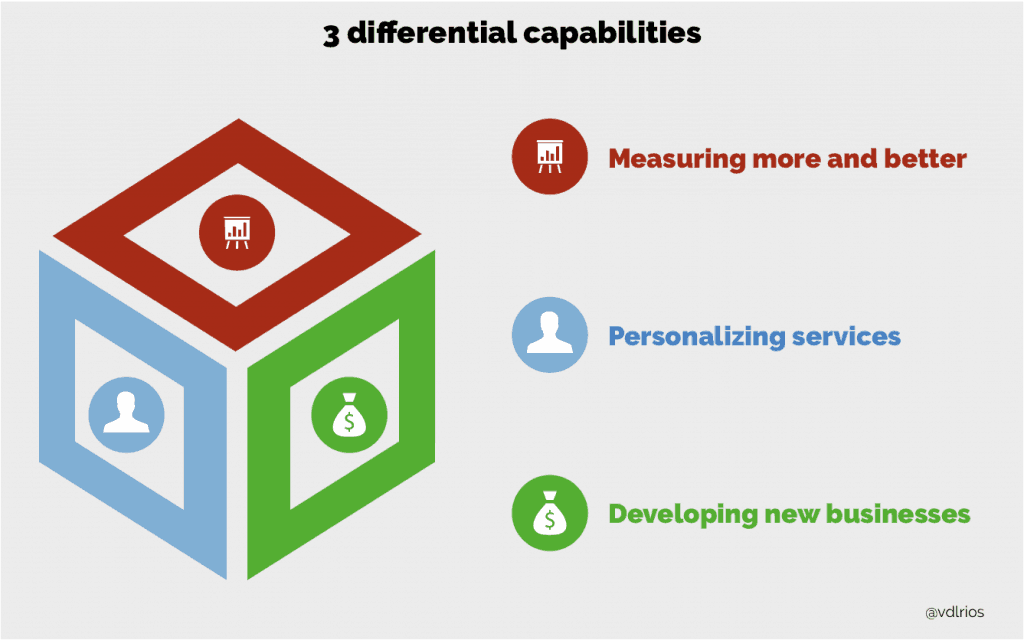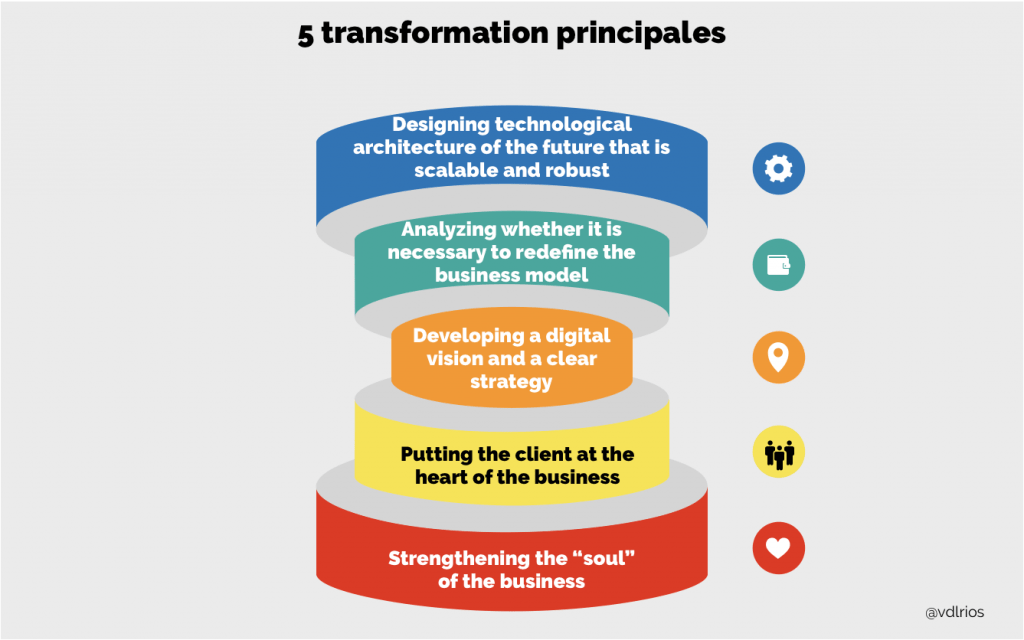
Digitalization and its technologies have enabled the development of a culture of “Servification” of roles and products on the consumer market (B2C) as well as on the business market (B2B). We rent cars or bikes by the minute instead of buying them; we rent monthly access to an infinite number of songs, books, or movies instead of amassing CDs, tomes, or DVDs.
For residents, these practices are complete novelties, but that’s not the case for businesses, who have traditionally resorted to externalizing many of their services. In general, these services are not considered strategic for the business or are not available on a sufficient scale to manage them efficiently and/or effectively. These externalization practices have generated numerous savings and improvements to businesses and public administrations, as well as important internal changes of a different sort: changes in business models, the structure of the profit and loss account (converting the investment budget into budgets for operating costs), organizations, the culture…
We can therefore say that businesses were ahead of the game in terms of many of the advantages of the culture of “everything as a service” now offered to private individuals. But we must reflect on what digitalization also brings to big businesses that provide this sort of large-scale services, as Ferrovial Services does.
Personally, I see three differential capacities that digitalization brings to this sort of business

- Measuring more and better: undoubtedly, the availability of a common (digital) language; developing technologies (the Internet of Things or high-speed networks) capable of sharing information from devices and connecting them; and storage, processing, analytics, and usage data technologies that provide Business Intelligence and Big Data enable more and better measurements. This undoubtedly offers a huge opportunity for businesses that provide services because it gives them three advantages:
- Better understanding the use of services by being able to improve resource management and guaranteeing customer satisfaction at lower costs, while simultaneously being able to optimize its margins
- Better estimating the costs of the service and being more competitive when it comes to giving offers in competition for providing services
- Defining new models of commercialization and billing for services that give clients more flexibility and enable them to optimize their usage
- Personalizing services: one of the main advantages that digitalization offers to businesses is the capacity to personalize the product and the experience for the client through digital tools. For example, the introduction of digital billboards with dynamic marketing abilities has signified a huge opportunity for personalizing publicity, even for each individual who may be in front of the device based on some of their facial features (age, physical characteristics, sex, and more). Without a doubt, these types of technologies are an advancement, though they logically involve a higher investment that some businesses or administrations may not be able to afford, and that can justify the added demands of big projects that the service businesses manage. This capacity for personalization enables supplying clients (for example, cities or businesses), for services that are closer to the final consumer or adapted to the final service provider’s budgets.
- Developing new businesses: the first two capacities oblige the service provider to have some valuable data and technological assets that enable them to develop a third capacity, which I think is going to be differential: offering their clients new services or businesses and even developing potential businesses for clients that they had but weren’t able to get off of the ground due to a lack of budget, assets, or capacities. This capacity is especially important in the field of public services, where being able to fund services for citizens with new sources of income is a very important tool for administrations, and it allows them to guarantee services and even improve them (consider, for example, how services at airports have evolved and the new opportunities travelers can now enjoy). This can enable a private business to generate new income through assets that aren’t profitable. As we said before, a service business’s ability to add demands and justify investments in digitalization will enable them to expand the services they offer in the future, and at the same time offer new services to end clients (for example, we are seeing this with the entrance of many of these companies into mobility businesses).
To be able to develop these three nuke differential capacities, the service business must develop its digital transformation based on 5 fundamental principles:

- Developing a digital vision and a clear strategy: it is vital to have a clear idea of what digitalization brings to our business.
- What are the opportunities and the risks that digitalization offers the business?
- What sectors may businesses come from to compete in the markets we’re already in?
- Is the threat from these newcomers really important? Will they change the sector’s business model?
- What sectors can we move into to compete?
- Does entering into these new sectors really add a differential value to our profit and loss account? To income? To profitability?
- How are we positioning our brand to be chosen by clients?
In this case, it will be highly necessary to have a clear vision of what digitalization can offer us overall and bet on the long-term over the short
- Analyzing whether it is necessary to redefine the business model: I think that one of the biggest challenges that digitalization carries is the change that business models are undergoing. Playing in a new world by the old rules is one of the most common mistakes companies are currently making. Analyzing whether the business model must be adjusted is critical: investments, the price scheme and policy, the cost and investment model, and amounts of profitability.
- Putting the client at the heart of the business: if there is one thing that digital leaders are especially good at, it is that they are “customer-centric” companies, as opposed to the traditional “product-centric” models. Digitalization is yet another opportunity to put the client at the center of things. In the case of service businesses, it is essential for them to not only be thinking of putting their client at the center but also their clients’ clients and the end-users of their services.
- Designing technological architecture of the future that is scalable and robust: there is no doubt that technology is critical in this digital revolution since it is the great enabler for many of the changes that are happening. As that enabler, it must be a means for transformation, and not an end in itself. First, there must be a clear idea of what the desired goal is and then decide what technology we can use to develop it. Of course, technology then offers many more business opportunities, but if there is no initial alignment, the risk of missing those opportunities is high. Betting on architecture with Cloud solutions, which enables scaling or reducing their capacity in terms of the business’s needs, is a great decision. This allows significantly reducing the time-to-market for launching new services or delivering products to clients, in addition to improving the profitability of investments. These platforms must be able to integrate digital technologies that are going to enable extracting the value of digitalization in businesses: artificial intelligence, the Internet of Things, Big Data, augmented and virtual reality, Blockchain, self-driving vehicles, RPA… These are just a few of them. Security is another critical aspect in terms of technology. The service business acts as a final service provider to a third party, and it assumes responsibility for protecting data not only for their client but, in many cases for their client’s client, as well. Lastly, modifying the way of working on technological developments and their implementations. Betting on methodologies like the “agile method,” as opposed to traditional ones like the “waterfall model,” allows substantially improving the results of businesses in transformation.
- Strengthening the “soul” of the business: it may seem strange to come across the word “soul” in an article on digitalization, but I intend to collect all aspects related to people under this umbrella term. Underneath it all, the processes of transformation ultimately depend on people, who are the ones who guarantee success or lead to the failure of the project. In this sense, we could say that this soul is made up of four important assets we must strengthen and help evolve:
- Leadership: this is the first critical lever we must develop. Do we have a leadership style to drive the transformation? To do so, it must be acknowledged that, only if the top three levels of the organization are committed to it will the lower levels be able to go in the right direction. It’s possible that the problem of leadership at many businesses may not have anything to do with digitalization directly, but instead with the essential evolution of the business itself. Digitalization may be a good excuse to adapt the leadership style to what the business currently needs.
- The organization: Do we have an organization that is prepared to drive the transformation? Businesses often suffer from organizations that are too focused on internal aspects instead of organizing around satisfying clients. The proliferation of “organizational silos” is clearly a handicap for guaranteeing the transformation’s results. It’s therefore desirable for the transformation project to be built on a new organization that takes the new challenges the business must face into account. And of course, understanding that digitalization is a project that affects all units, not just the technical ones.
- Culture: Is the business’s culture compatible with the transformation? Digitalization requires an important change in teams’ habits. Just as I said before about clients, digitalization gives us a new opportunity to attempt to deal with some traditional lacks that businesses have: truly working for the employees’ satisfaction, fostering teamwork, committing to the development of individuals, and developing an efficient communication policy that makes all employees responsible and protagonists of change. Within the culture, I also believe the ability to work with third parties, sometimes even with competitors, is very important.
- Talent: Do we have the talent necessary for these changes? These four points are absolutely related to people, and they clearly must be ready for the transformation. Some businesses think that digitalization is a matter of incorporating people from digital businesses. I think that is a mistake. Very often, these people are used to a totally different environment, and they come to a business where they don’t find anything they had at their previous business. It is important to incorporate external talent, but, to me, it’s much more important to develop internal talent, and that is often done through training as well as measures like rotations within the organization and setting new challenges.
I think that digitalization is a great opportunity to transform service businesses, and I also believe that they are truly very well-positioned to be able to rely on the transformation projects of many of their clients, which offer many of the services we residents and consumers use every day. There is not a doubt in my mind that, over the next few years, a significant portion of society’s well-being will depend largely on the results of these transformation processes.





There are no comments yet